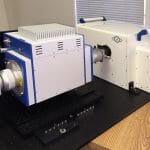In mechanical engineering, electronically controlled drives for controlling uneven motion sequences have become increasingly established as an alternative to standard mechanical cam discs. Eccentrics, crankshafts and toggle levers are integral to many production machines in the textiles, printing and packaging industries: they drive mechanical motion in linear and non-linear kinematics. The COMBIVERT F6 and S6 drive controllers from KEB provide optimal control of these movements.
For dynamic and precise implementation of complex motion sequences, a new feed-forward algorithm has been implemented in the COMBIVERT F6 and S6 drive controllers. The software is able to regulate the engine torque so that it corresponds exactly to the required torque for the downstream mechanical system. As a result, the following errors are limited to an optimal minimum:
Inertia and load profile
Feed-forward of the control structure to a constant mass moment of inertia is normal, but only practical for simple linear kinematics. In non-linear movements and uneven specifications, the inertia and therefore the feed-forward control depend on the path or angle.
To harmonise the feed-forward algorithm with the application, the load profile is identified by means of a simulation or test drive. The non-linear torque feed-forward of the drive controller is parameterised based on these values.
Errors reduced tenfold
The feed-forward control operates both in the rotary value range for the position, as well as in the linear value range. In the rotary area, the transition from minimum to maximum value and vice versa forms an imaginary circle, which is cyclically traversed.
In the linear value range, the drive moves between minimum and maximum position.
By default, the non-linear feed-forward takes place over the entire movement or the entire route. Alternatively, this can also be achieved for just a sub-section (defined angle range / defined distance). The feed-forward control can therefore be even more accurate and detailed.
As a result, the use of the feed-forward algorithm means the positional tracking error can be reduced tenfold compared to a solution without feed-forward control. This serves to further refine the high control accuracy of the COMBIVERT S6 and F6 drives. Identical properties are represented in the COMBIVERT H6 multi-axis system, that is to say, this feature is available in both single and multi-axis applications with identical performance.









